A Framework for Mooring and Anchor Design in Sand Considering Seabed Trenches Based on Floater Hydrodynamics
Abstract
:1. Introduction
2. Literature Review
3. Objective and Novelty
4. Methodology
- (1)
- Hydrodynamic calculation of the floater: Based on the AQWA (ANSYS, 2019), the hydrodynamic analyses of a floater coupled with its mooring system were conducted to obtain the frequency and time domain responses. The positioning performances of the mooring system were evaluated, and the cyclic displacement curves of the fairlead were obtained. The outputs, e.g., mooring line tension and fairlead displacement, are the inputs of the seabed trenching evaluation.
- (2)
- Seabed trenching evaluation: Considering the seabed properties, the dynamic calculation of a typical single mooring line was carried out based on COMSOL, and the possible trench profiles were evaluated based on the mooring line–seabed interaction model. The outputs, e.g., trench dimension and tension at anchor padeye, are the inputs of the anchor selection and capacity analyses.
- (3)
- Anchor selections and capacity analyses: The applicability of the suction anchor was first assessed based on its installation and capacity analysis. A refined anchor, the caisson–plate gravity anchor (CPGA), was proposed, and FE analyses based on ABAQUS were adopted to verify whether it meets the design requirements [32].
5. Model Descriptions and Results
5.1. Hydrodynamics of Floating Platform
5.1.1. Design Parameters and Numerical Models
- (1)
- Basic Design Requirements
- (2)
- Floating platform
- (3)
- Mooring system design
5.1.2. Hydrodynamic Calculation Results
- (1)
- Frequency Domain Analysis Results
- (2)
- Time domain analysis results
5.2. Evaluation of Seabed Trench Profile
5.2.1. Calculation Method
5.2.2. Calculation Results
5.3. Anchor Design and Capacity Analyses
5.3.1. Suction Anchor Evaluation
5.3.2. Caisson–Plate Gravity Anchor
- (1)
- Preliminary size design
- (2)
- Finite element verification
6. Limitations and Recommendations
7. Conclusions
- (1)
- In the hydrodynamic calculation of the floating platform, the tensions of mooring lines l1 and l2 resist the maximum loads under the 45° load condition, and the tension difference between these two mooring lines is small. The maximum load at the seabed fixed point appears under the 45° load condition, which is adopted as the input value to design the anchor. Under a 90° load condition, the resultant displacement reaches the maximum value of 7.43 m, which is adopted in the trench profile evaluation.
- (2)
- In the sand seabed, due to the sand’s high shear strength, it is difficult for the mooring line to penetrate into the soil, especially for the catenary mooring system. Thus, repeatedly disturbing and degrading the shallow soil by the mooring line no longer occurs, and the load direction at the padeye always remains vertical. According to this study, a trench is difficult to form under the condition of the catenary mooring system and sand seabed.
- (3)
- The applications of different anchors were evaluated. A suction anchor is not suitable as an anchor for carbonate sand, considering its installation and bearing capacity. Combined with engineering cases, the caisson–plate gravity anchor (CPGA) was applied and verified with the FE method. The results show that soil displacement in the caisson basically presents a translational failure mode, and two wedge-type regions appear, one in front of the caisson and one at the back of the caisson. Under the limit state, the soil stress under the cover plate and in front of the caisson is significantly enhanced. The length of the soil stress region extends to the plate edge, and the depth reaches the caisson bottom. Compared with the soil stress in front of the caisson, the stress in the caisson is much smaller, which indicates that the major resistance mobilizes from the front region. The finite element calculation indicates that the designed dimensions meet the requirements.
Author Contributions
Funding
Institutional Review Board Statement
Informed Consent Statement
Data Availability Statement
Conflicts of Interest
References
- Randolph, M.F.; Gaudin, C.; Gourvenec, S.M.; White, D.J.; Boylan Cassidy, M.J. Recent advances in offshore geotechnics for deep water oil and gas developments. Ocean. Eng. 2011, 38, 818–834. [Google Scholar] [CrossRef] [Green Version]
- Randolph, M.; Cassidy, M.; Gourvenec, S.; Erbrich, C. Challenges of offshore geotechnical engineering. In Proceedings of the International Conference on Soil Mechanics and Geotechnical Engineering, Buenos Aires, Argentina, 15–18 November 2015; AA Balkema Publishers: Rotterdam, The Netherlands, 2005; Volume 16, p. 123. [Google Scholar]
- Soukissian, T.H.; Denaxa, D.; Karathanasi, F.; Prospathopoulos, A.; Sarantakos, K.; Iona, A.; Mavrakos, S. Marine renewable energy in the Mediterranean Sea: Status and perspectives. Energies 2017, 10, 1512. [Google Scholar] [CrossRef] [Green Version]
- Hemer, M.A.; Manasseh, R.; McInnes, K.L.; Penesis, I.; Pitman, T. Perspectives on a way forward for ocean renewable energy in Australia. Renew. Energy 2018, 127, 733–745. [Google Scholar] [CrossRef]
- Guo, Z.; Wang, L.; Yuan, F. Quasi-static analysis of the multicomponent mooring line for deeply embedded anchors. J. Offshore Mech. Arct. Eng. 2016, 138, 9. [Google Scholar] [CrossRef]
- Rui, S.; Guo, Z.; Wang, L.; Yang, H.; Zhou, W. Axial interaction between anchor chain and sand. Part II: Cyclic loading test. Appl. Ocean. Res. 2021, 114, 102815. [Google Scholar] [CrossRef]
- Rui, S.J.; Wang, L.Z.; Guo, Z.; Zhang, H.J.; Zhou, W.J. Axial interaction between anchor chain and sand. Part I: Monotonic loading test. Appl. Ocean. Res. 2021, 113, 102761. [Google Scholar] [CrossRef]
- Degenkamp, G.; Dutta, A. Soil resistances to embedded mooring line in soft clay. J. Geotech. Geoenviron. Eng. 1989, 115, 1420–1438. [Google Scholar] [CrossRef]
- Wang, L.; Guo, Z.; Yuan, F. Three-dimensional interaction between anchor chain and seabed. Appl. Ocean. Res. 2010, 32, 404–413. [Google Scholar] [CrossRef]
- Wang, L.; Guo, Z.; Yuan, F. Quasi-static three-dimensional analysis of suction anchor mooring system. Ocean. Eng. 2010, 37, 1127–1138. [Google Scholar] [CrossRef]
- Stanier, S.; White, D.; Chatterjee, S.; Brunning, P.; Randolph, M. A tool for ROV-based seabed friction measurement. Appl. Ocean. Res. 2015, 50, 155–162. [Google Scholar] [CrossRef]
- Frankenmolen, S.; White, D.; O’Loughlin, C. Chain-soil interaction in carbonate sand. In Proceedings of the Offshore Technology Conference, Houston, TX, USA, 2–5 May 2011; OnePetro: Richardson, TX, USA, 2016. [Google Scholar]
- Gaudin, C.; Cassidy, M.J.; O’Loughlin, C.D.; Tian, Y.; Wang, D.; Chow, S. Recent advances in anchor design for floating structures. Int. J. Offshore Polar Eng. 2017, 27, 44–53. [Google Scholar] [CrossRef]
- Richardson, M.D. Dynamically Installed Anchors for Floating Offshore Structures. Ph.D. Thesis, University of Western Australia, Perth, Australia, 2008. [Google Scholar]
- Diaz, B.D.; Rasulo, M.; Aubeny, C.P.; Fontana, C.M.; Arwade, S.R.; DeGroot, D.J.; Landon, M. Multiline anchors for floating offshore wind towers. In OCEANS 2016 MTS/IEEE Monterey; IEEE: Piscataway, NJ, USA, 2016; pp. 1–9. [Google Scholar]
- Liang, Z.; Jeng, D.S.; Liu, J. Combined wave–current induced seabed liquefaction around buried pipelines: Design of a trench layer. Ocean. Eng. 2020, 212, 107764. [Google Scholar] [CrossRef]
- Xiong, L.Z.; White, D.J.; Neubecker, S.R.; Zhao, W.H.; Yang, J.M. Anchor loads in taut moorings: The impact of inverse catenary shakedown. Appl. Ocean. Res. 2017, 67, 225–235. [Google Scholar] [CrossRef]
- Xiong, L.Z.; Yang, J.M.; Zhao, W.H. Dynamics of a taut mooring line accounting for the embedded anchor chains. Ocean. Eng. 2016, 121, 403–413. [Google Scholar] [CrossRef]
- Bhattacharjee, S.; Majhi, S.M.; Smith, D.; Garrity, R. Serpentina FPSO mooring integrity issues and system replacement: Unique fast track approach. In Proceedings of the Offshore Technology Conference, Houston, TX, USA, 5–8 May 2014. OTC-25449-MS. [Google Scholar]
- Sassi, K.; Kuo, M.Y.H.; Versteele, H.; Cathie, D.N.; Zehzouh, S. Insights into the Mechanisms of Mooring line Trench Formation. In Proceedings of the Presented at the Offshore Site Investigations and Geotechnics Conference, London, UK, 10–12 September 2017; Society for Underwater Technology: London UK, 2017. [Google Scholar]
- Hess, 2015. Ivanhoe and Rob Roy Fields Decommissioning Programmes. No. ABD-DCO-RPT_01000 Issued December 2015. Available online: https://assets.publishing.service.gov.uk/government/uploads/system/uploads/attachment_data/file/586257/IVRR_Close_out_Report.pdf (accessed on 1 May 2023).
- Colliat, J.L.; Safinus, S.; Boylan, N.; Schroeder, K. Formation and Development of Seabed Trenching from Subsea Inspection Data of Deepwater Gulf of Guinea Moorings. In Proceedings of the Offshore Technology Conference, Houston, TX, USA, 30 April–3 May 2018. OTC-29034-MS. [Google Scholar]
- Hernandez-Martinez, F.G.; Saue, M.; Schroder, K.; Jostad, H.P. Trenching Effects on Holding Capacity for in-Service Suction Anchors in High Plasticity Clays. In Proceedings of the SNAME 20th Offshore Symposium, Houston, TX, USA, 17 February 2015; OnePetro: Richardson, TX, USA, 2015. [Google Scholar]
- Arslan, H.; Peterman, B.R.; Wong, P.C.; Bhattacharjee, S. Remaining capacity of the suction pile due to seabed trenching. In Proceedings of the Presented at the International Ocean and Polar Engineering Conference, Kona, HI, USA, 21–26 June 2015. [Google Scholar]
- Alderlieste, E.; Romp, R.; Kay, S.; Lofterød, A. Assessment of seafloor trench for suction pile moorings: A field case. In Proceedings of the Offshore Technology Conference, Houston, TX, USA, 2–5 May 2016. OTC-27035-MS. [Google Scholar]
- Feng, X.; Gourvenec, S.; White, D.J. Load capacity of caisson anchors exposed to seabed trenching. Ocean. Eng. 2019, 171, 181–192. [Google Scholar] [CrossRef] [Green Version]
- Randolph, M.F. A Lifetime of Offshore Geotechnics-Career Reflections and Lessons Learned; University of Western Australia: Perth, Australia, 2020. [Google Scholar]
- Cathie, D.; Sassi, K.; Blanc, M.; Thorel, L.; Wallerand, R. Holding capacity of suction anchors with trench-centrifuge test results and interpretation. In Proceedings of the 4th International Symposium on Frontiers in Offshore Geotechnics, Austin, TX, USA, 28–31 August 2022; Deep Foundation Institute-DFI: Hawthorne, NJ, USA, 2020; p. 352. [Google Scholar]
- Sassi, K.; Zehzouh, S.; Blanc, M.; Thorel, L.; Cathie, D.; Puech, A.; Colliat-Dangus, J.L. Effect of seabed trenching on the holding capacity of suction anchors in soft deepwater Gulf of Guinea clays. In Proceedings of the Offshore Technology Conference, Houston, TX, USA, 2–5 May 2011; OnePetro: Richardson, TX, USA, 2018. [Google Scholar]
- Rui, S.J.; Guo, Z.; Wang, L.Z.; Wang, H.; Zhou, W.J. Inclined loading capacity of caisson anchor in South China Sea carbonate sand considering the seabed soil loss. Ocean. Eng. 2022, 260, 111790. [Google Scholar] [CrossRef]
- Wang, L.; Rui, S.; Guo, Z.; Gao, Y.; Zhou, W.; Liu, Z. Seabed trenching near the mooring anchor: History cases and numerical studies. Ocean. Eng. 2020, 218, 108233. [Google Scholar] [CrossRef]
- Hibbitt, K. Sorensen; ABAQUS User’s Manual Inc.: Pawtucket, RI, USA, 2008. [Google Scholar]
- American Petroleum Institute. Recommended Practice for Design and Analysis of Station Keeping Systems for Floating Structures; American Petroleum Institute: Washington, WA, USA, 2005. [Google Scholar]
- He, S.H.; Goudarzy, M.; Ding, Z.; Sun, Y.; Xia, T.D. The effect of loading frequency on the long-term cyclic behavior of dense calcareous sand. Can. Geotech. J. 2022, 59, 1285–1291. [Google Scholar] [CrossRef]
- He, S.H.; Shan, H.F.; Xia, T.D.; Liu, Z.J.; Ding, Z.; Xia, F. The effect of temperature on the drained shear behavior of calcareous sand. Acta Geotech. 2021, 16, 613–633. [Google Scholar] [CrossRef]
- Rui, S.J.; Guo, Z.; Si, T.L.; Li, Y.J. Effect of particle shape on the liquefaction resistance of calcareous sands. Soil dyn. Earthq. Eng. 2020, 137, 106302. [Google Scholar] [CrossRef]
- Zhang, W.; Zhou, Z.; Pradhan, D.L.; Wang, P.; Jin, H. Design considerations of drag anchors in cohesive soil for floating facilities in the South China sea. Mar. Struct. 2022, 81, 103101. [Google Scholar] [CrossRef]
- Liu, H.X.; Peng, J.S.; Zhao, Y.B. Analytical study of the failure mode and pullout capacity of suction anchors in sand. Ocean Syst. Eng. 2015, 5, 279–299. [Google Scholar] [CrossRef]
- Liu, H.X.; Wang, C.; Zhao, Y.B. Analytical study of the failure mode and pullout capacity of suction anchors in clay. Ocean Syst. Eng. 2013, 3, 79–95. [Google Scholar] [CrossRef] [Green Version]
- Guo, Z.; Jeng, D.S.; Guo, W.; Wang, L. Failure mode and capacity of suction caisson under inclined short-term static and one-way cyclic loadings. Mar. Georesour. Geotechnol. 2018, 36, 52–63. [Google Scholar] [CrossRef] [Green Version]
- Guo, Z.; Jeng, D.S.; Guo, W.; He, R. Simplified approximation for seepage effect on penetration resistance of suction caissons in sand. Ships Offshore Struct. 2017, 12, 980–990. [Google Scholar] [CrossRef]
- Guo, Z.; Wang, L.; Yuan, F.; Li, L. Model tests on installation techniques of suction caissons in a soft clay seabed. Appl. Ocean. Res. 2012, 34, 116–125. [Google Scholar] [CrossRef]
- Liu, X.; Wu, W.; El Naggar, M.H.; Wang, K.; Mei, G.; Liu, H.; Wang, L.; Sun, J. A simplified non-axisymmetric pile-soil interaction model for pile integrity testing analysis. Appl. Math. Model. 2023, 119, 137–155. [Google Scholar] [CrossRef]
- Wu, W.; Bauer, E. A simple hypoplastic constitutive model for sand. Int. J. Numer. Anal. Methods Geomech. 1994, 18, 833–862. [Google Scholar] [CrossRef]
- Liang, J.; Du, X.; Fang, H.; Du, M.; Shi, M.; Gao, X.; Han, Y. Numerical and experimental study of diffusion law of foamed polymer grout in fracture considering viscosity variation of slurry. Tunn. Undergr. Space Technol. 2022, 128, 104674. [Google Scholar] [CrossRef]
- Rui, S.J.; Wang, L.Z.; Guo, Z.; Cheng, X.M.; Wu, B. Monotonic behavior of interface shear between carbonate sands and steel. Acta Geotech. 2021, 16, 167–187. [Google Scholar] [CrossRef]
- Rui, S.J.; Wang, L.Z.; Guo, Z.; Zhou, W.J.; Li, Y.J. Cyclic behavior of interface shear between carbonate sand and steel. Acta Geotech. 2021, 16, 189–209. [Google Scholar] [CrossRef]
- Zhou, Z.; O’Loughlin, C.D.; White, D.J.; Stanier, S.A. Improvements in plate anchor capacity due to cyclic and maintained loads combined with consolidation. Géotechnique 2020, 70, 732–749. [Google Scholar] [CrossRef]
- Zhou, Z.; White, D.J.; O’Loughlin, C.D. An effective stress framework for estimating penetration resistance accounting for changes in soil strength from maintained load, remoulding and reconsolidation. Géotechnique 2019, 69, 57–71. [Google Scholar] [CrossRef] [Green Version]
- Rui, S.; Zhang, H.; Xu, H.; Zha, X.; Xu, M.; Shen, K. Seabed structures and foundations related to deep-sea resource development: A review based on design and research. Deep. Undergr. Sci. Eng. 2023, 1–18. [Google Scholar] [CrossRef]
- Zhou, Z.; White, D.J.; O’Loughlin, C.D. The changing strength of carbonate silt: Parallel penetrometer and foundation tests with cyclic loading and reconsolidation periods. Can. Geotech. J. 2020, 57, 1664–1683. [Google Scholar] [CrossRef]


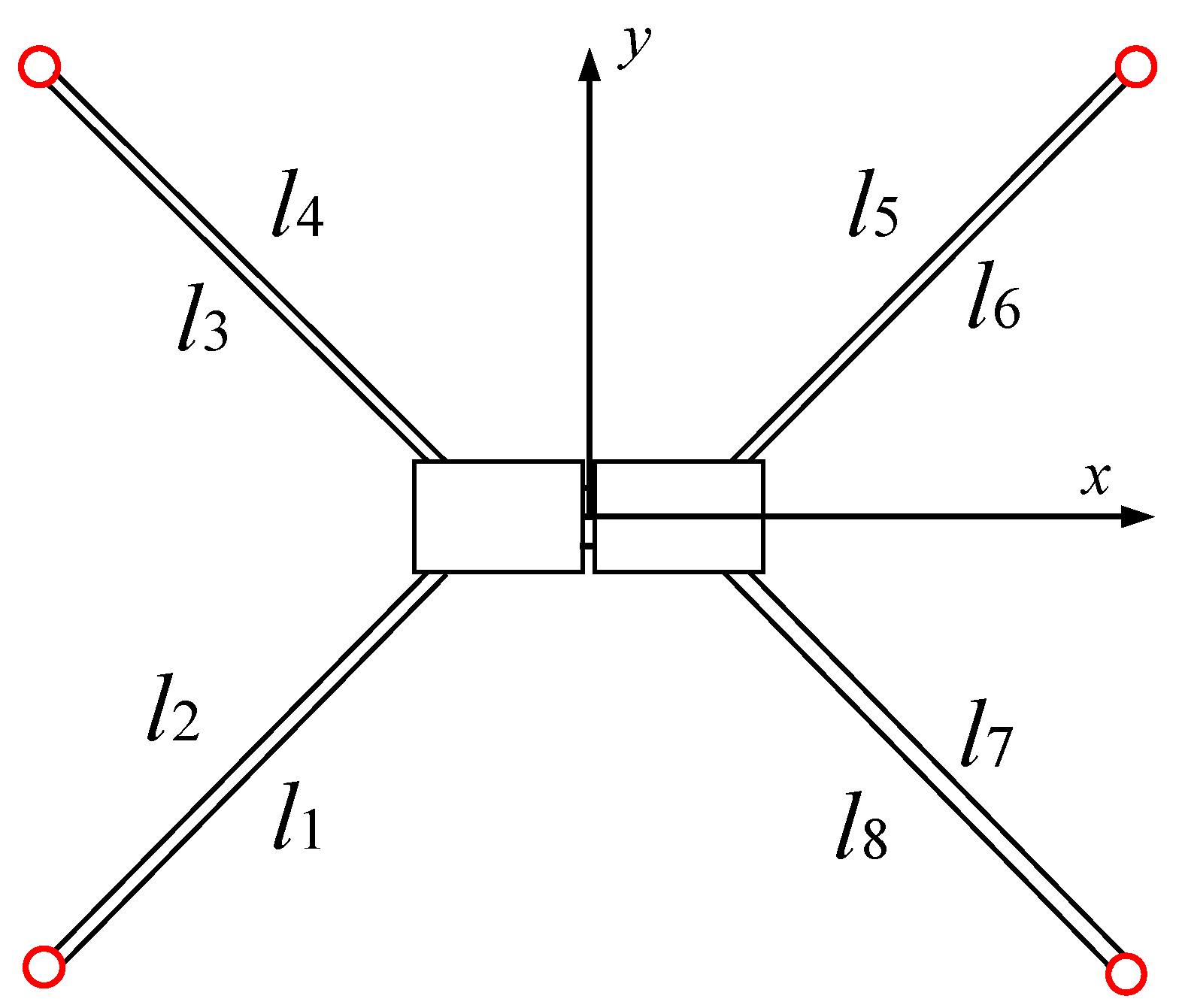


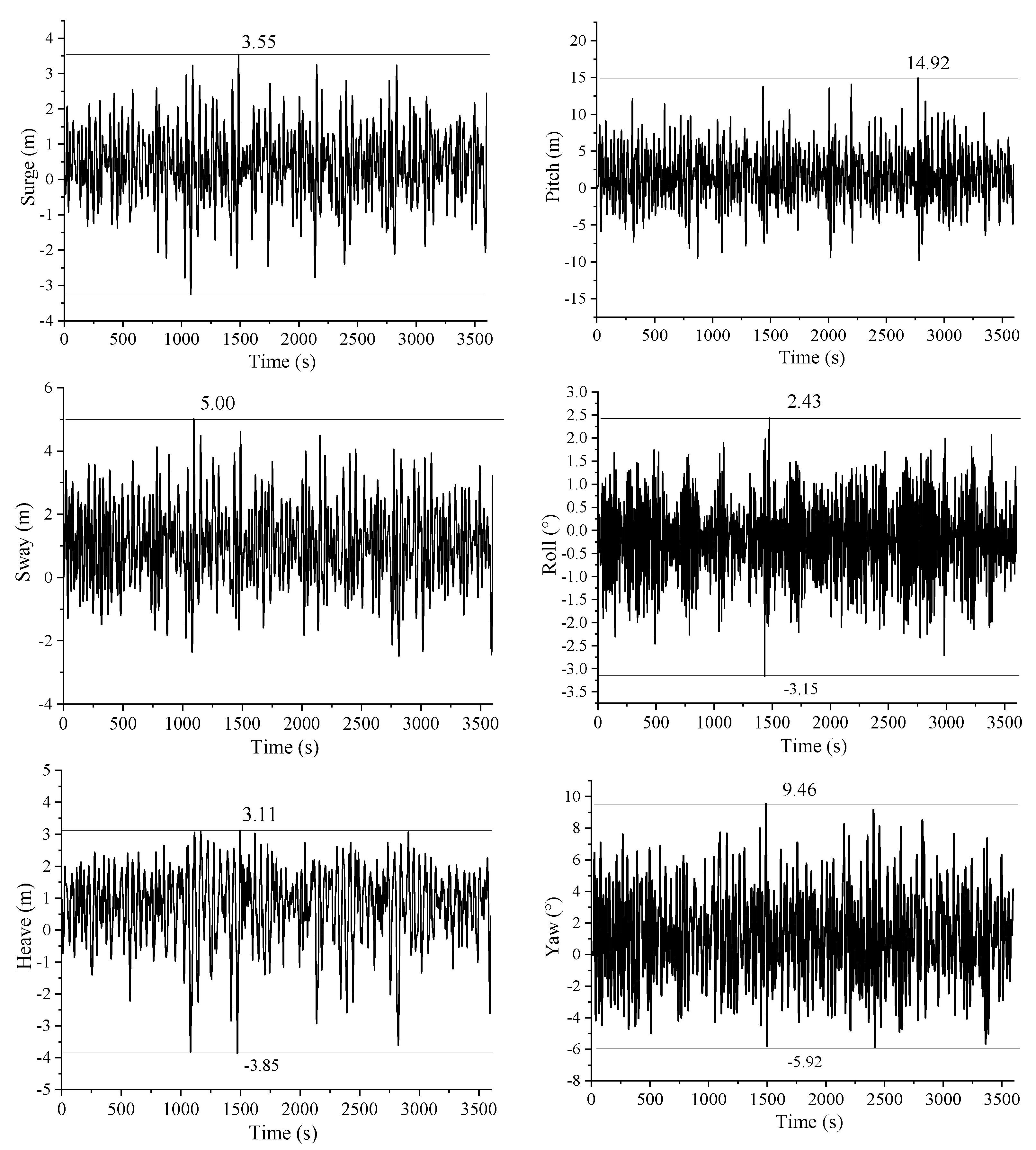





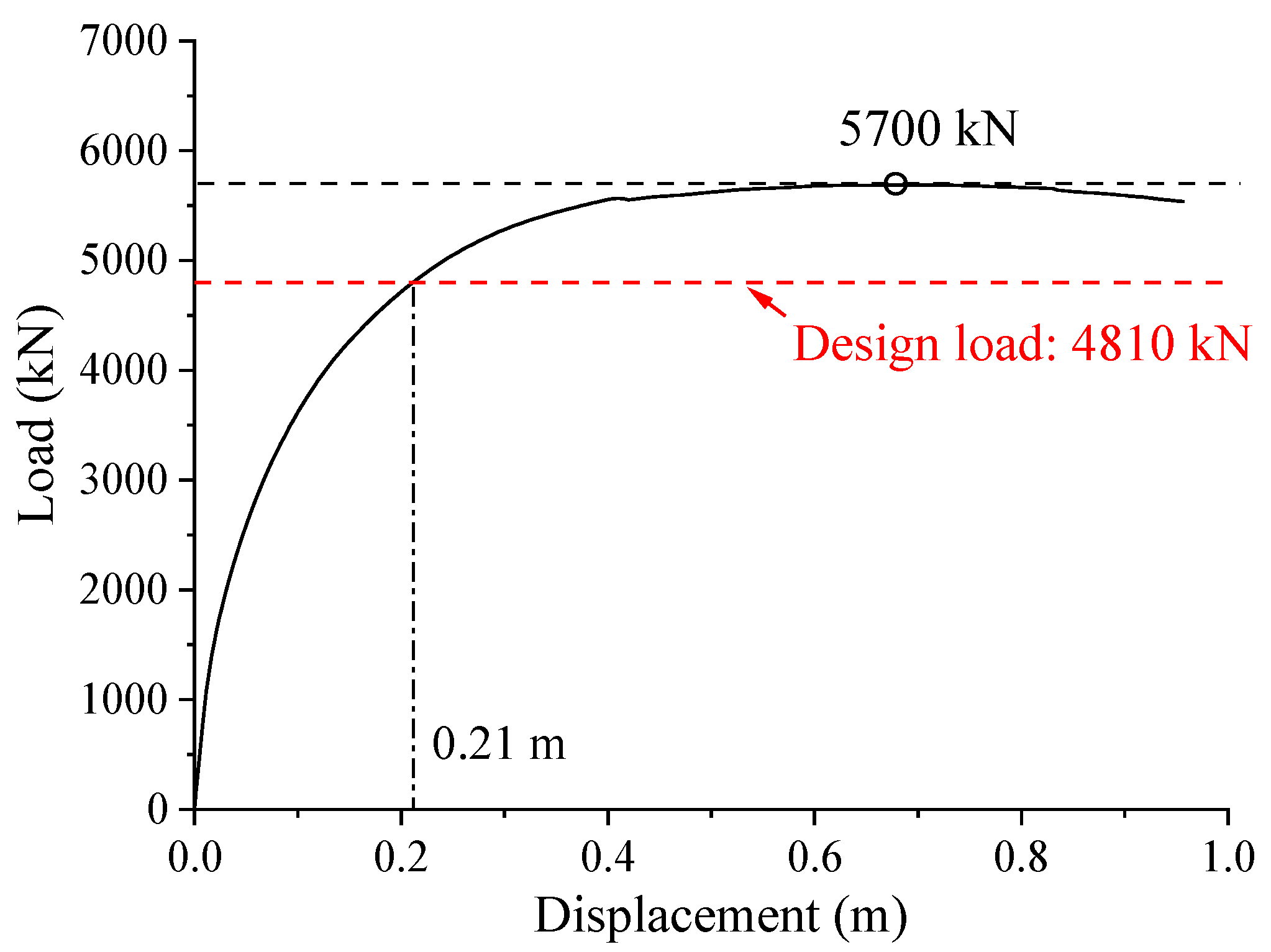
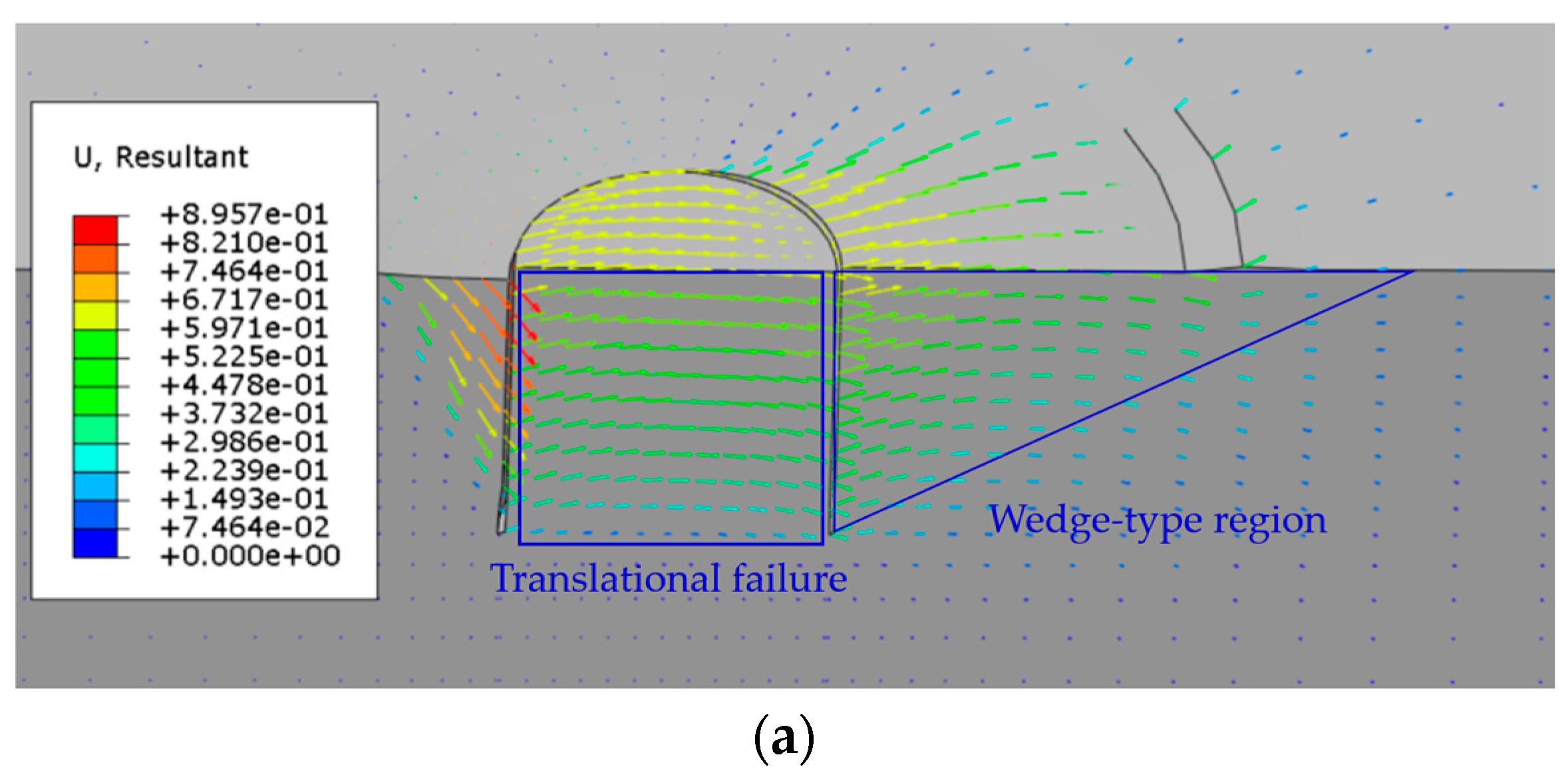
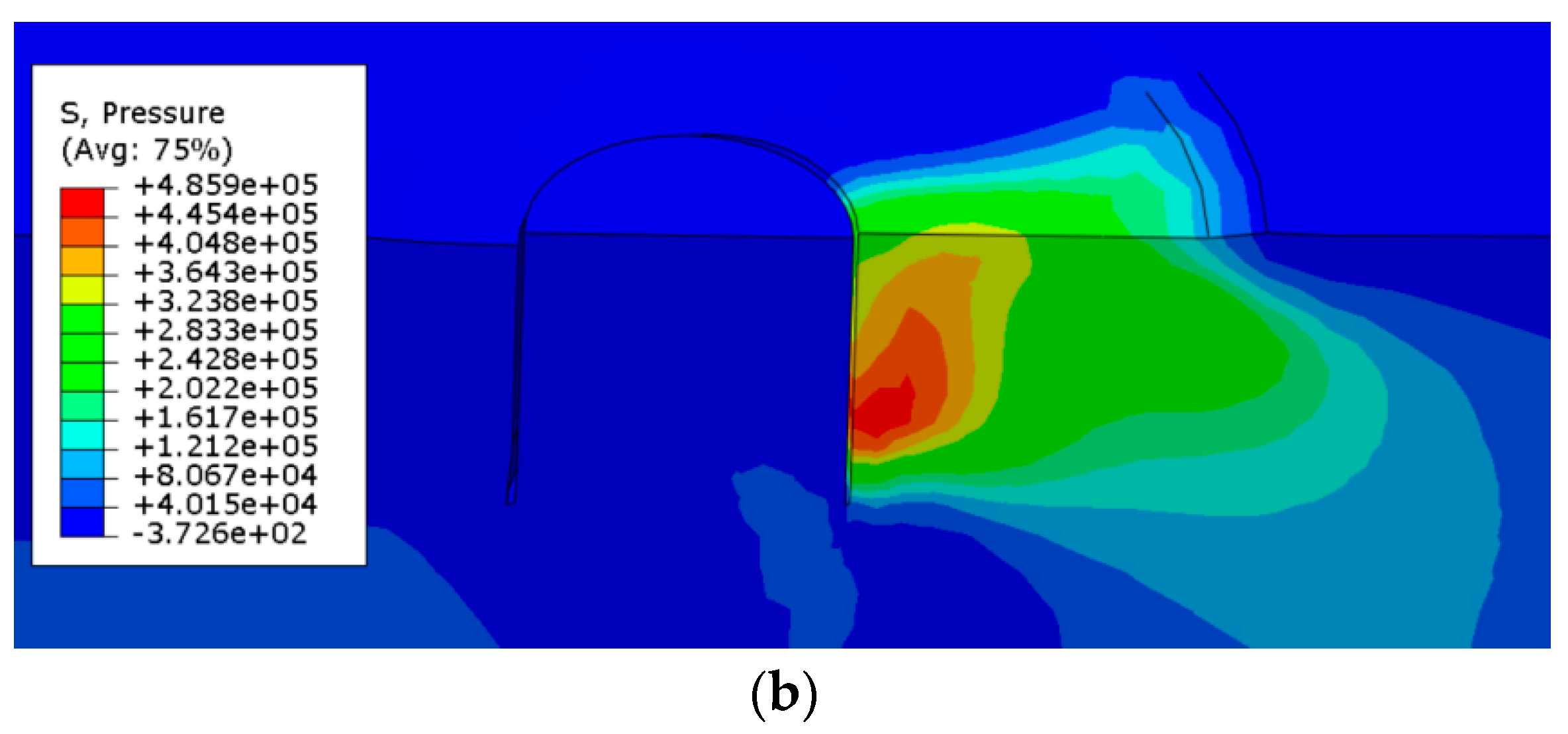
| Average Wind Speed Vw (m/s) | Significant Wave Height Hs (m) | Spectral Peak Period Tp (s) | Current Velocity Vc (m/s) | |
|---|---|---|---|---|
| Survival condition | 46.2 | 4.0 | 9.1 | 1.0 |
| Operational condition | 8.0 | 1.0 | 4.5 | 0.3 |
| Parameters | Values |
|---|---|
| Total length | 63 m |
| Total width | 25 m |
| Single module length | 30 m |
| Module height | 14.2 m |
| Module draft | 5.5 m |
| Total displacement | 1827 t |
| Wind | Current | |||
|---|---|---|---|---|
| x | y | x | y | |
| Area (m2) | 137.7 | 152.7 | 109.5 | 116.5 |
| Force coefficient (N/(m/s)2) | 105.7 | 117.2 | 66,781.3 | 71,050.4 |
| Codes | Fairlead on the Platform | Fixed Point on the Seafloor | ||||
|---|---|---|---|---|---|---|
| x (m) | y (m) | z (m) | x (m) | y (m) | z (m) | |
| l1 | −26.4 | −12.5 | 0.5 | −146.6 | −132.7 | −40.0 |
| l2 | −29 | −12.5 | 0.5 | −149.2 | −132.7 | −40.0 |
| l3 | −29 | 12.5 | 0.5 | −149.2 | 132.7 | −40.0 |
| l4 | −26.4 | 12.5 | 0.5 | −146.6 | 132.7 | −40.0 |
| l5 | 26.4 | 12.5 | 0.5 | 146.6 | 132.7 | −40.0 |
| l6 | 29 | 12.5 | 0.5 | 149.2 | 132.7 | −40.0 |
| l7 | 29 | −12.5 | 0.5 | 149.2 | −132.7 | −40.0 |
| l8 | 26.4 | −12.5 | 0.5 | 146.6 | −132.7 | −40.0 |
| Mooring Line Position | Components | Length (m) | Feature Diameter (mm) | Breaking Force (kN) | Mass (kg/m) |
|---|---|---|---|---|---|
| Upper part | Polyethylene | 10 | 194 | 19,600 | 17.2 |
| Middle part | Nylon | 75 | 259 | 19,600 | 46.8 |
| Transition part | Chain | 6 | 120 (db) | 13,573 | 288 |
| Ground part | Chain | 88 | 208 (db) | 34,619 | 862 |
| Parameters | Incident Load Direction | ||
|---|---|---|---|
| 0° | 90° | 45° | |
| Surge (m) | 4.78 | 0.19 | 3.55 |
| Sway (m) | 0 | 6.19 | 5 |
| Heave (m) | 3.6 | 4.1 | 3.11 |
| Resultant displacement (m) | 5.98 | 7.43 | 6.88 |
| Pitch (°) | 0 | 17.69 | 14.92 |
| Rolling (°) | 4.29 | 0.74 | 2.43 |
| Yaw (°) | 0 | 1.39 | 9.46 |
| Tension at fixed point (kN) | 878.25 | 1141.5 | 1503 |
| Parameter Types | Parameters | Values |
|---|---|---|
| Floating platform displacement | Motion amplitude, Af | 7.43 m |
| Balance position distance, R | 170 m | |
| Cyclic period, Tf | 100 s | |
| Mooring line | Anchor padeye depth, de | 6 m |
| Mooring line length, L | 179 m | |
| Seabed soil | Saturated unit weight, γs | 18 kN/m3 |
| Sand critical friction angle, φ | 36.2° | |
| Interface friction angle, δ | 26° |
| Parameters | Values |
|---|---|
| Caisson outer diameter, d | 3.7 m |
| Caisson embedded depth, h | 3.7 m |
| Caisson wall thickness, t | 44 mm |
| Cover plate diameter, D | 11.1 m |
| Vertical pressure of the cover plate, Vp | 16 kPa |
| Anchor total weight, W | 164.3 t |
Disclaimer/Publisher’s Note: The statements, opinions and data contained in all publications are solely those of the individual author(s) and contributor(s) and not of MDPI and/or the editor(s). MDPI and/or the editor(s) disclaim responsibility for any injury to people or property resulting from any ideas, methods, instructions or products referred to in the content. |
© 2023 by the authors. Licensee MDPI, Basel, Switzerland. This article is an open access article distributed under the terms and conditions of the Creative Commons Attribution (CC BY) license (https://creativecommons.org/licenses/by/4.0/).
Share and Cite
Rui, S.; Xu, H.; Teng, L.; Xi, C.; Sun, X.; Zhang, H.; Shen, K. A Framework for Mooring and Anchor Design in Sand Considering Seabed Trenches Based on Floater Hydrodynamics. Sustainability 2023, 15, 9403. https://doi.org/10.3390/su15129403
Rui S, Xu H, Teng L, Xi C, Sun X, Zhang H, Shen K. A Framework for Mooring and Anchor Design in Sand Considering Seabed Trenches Based on Floater Hydrodynamics. Sustainability. 2023; 15(12):9403. https://doi.org/10.3390/su15129403
Chicago/Turabian StyleRui, Shengjie, Hang Xu, Long Teng, Chen Xi, Xingye Sun, Haojie Zhang, and Kanmin Shen. 2023. "A Framework for Mooring and Anchor Design in Sand Considering Seabed Trenches Based on Floater Hydrodynamics" Sustainability 15, no. 12: 9403. https://doi.org/10.3390/su15129403





